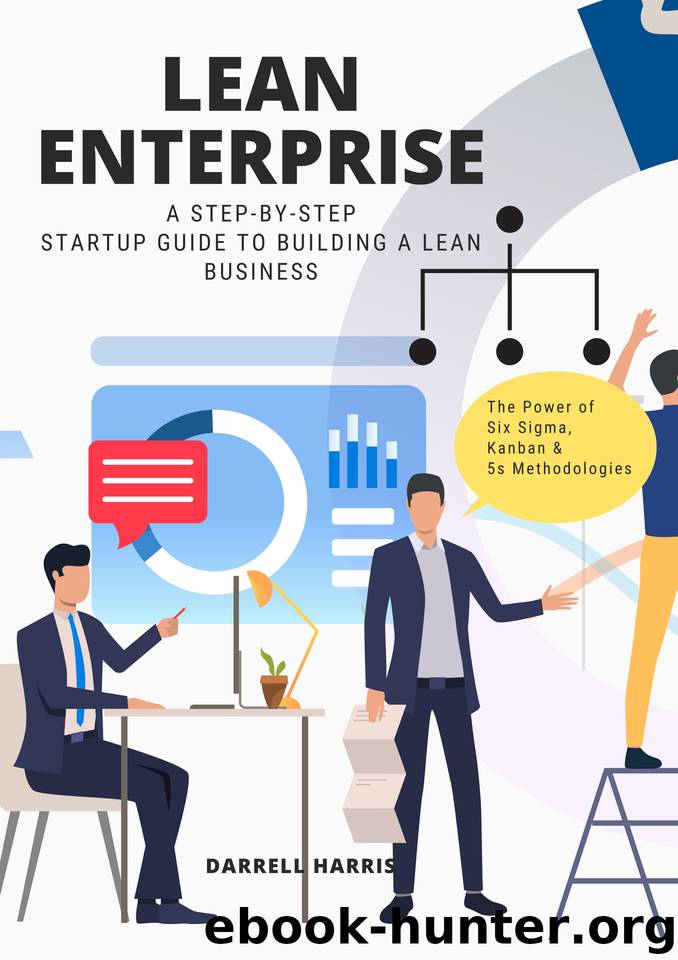Lean Enterprise: A Step-by-Step Startup Guide to Building a Lean Business by Harris Darrell

Author:Harris, Darrell [Harris, Darrell]
Language: eng
Format: epub
Published: 2020-03-03T16:00:00+00:00
Chapter 5:
Lean and Production
When putting together a Lean system for your business, you will ultimately determine where the waste hides in your current processes, and then it's time to consider what can be done about the flow of the process. The answer will often come in the form of a continuous flow model or a batch model.
Continuous flow model: the ideal version of the continuous flow model sees the customer ordering a product or service before the necessary steps are taken to generate the product or service for which payment is made. The product or service is then delivered to the customer who then pays for his order. The end result here is that there is no downtime between the time the customer submits his request and the time it is completed. In addition, each step flows smoothly into the next to ensure that the total downtime is limited as much as possible.
The main advantage of the continuous power model is that it enables companies to make assumptions and plan the future based on a profit level that gives priority to continuity and stability. A continuous flow arrangement also results in less waste than other types of processes. The biggest disadvantage, however, is that such scenarios can be difficult to produce because every step in the process is rarely the same, no matter how clear the value flow chart can be. If you are striving to create a continuous process scenario, you must be aware that new problems can also occur quickly if your available margin of error starts to shrink.
To continue to exist despite these disadvantages, you want to do your best to address these issues head-on and be determined to continue them as you hope for success. In addition, if you hope to choose this route, it is important to start your journey to a Lean system with this in mind, because a continuous system only works if every part of the system is fully in sync with the rest.
Heijunka is a useful tool when it comes to facilitating this process, because it promotes the quantity and quality of the process over a longer period in the hope of making everything as efficient as possible and, moreover, explicitly preventing batching. While it may sound complicated, this process can be as simple as making sure your team has all the storage they need to organize the different parts of the project. They store them in folders that are organized based on both the usage frequency and the expiration date. Folders that are currently in use can be stacked vertically on top of each other, while folders that are inactive can be stored somewhere horizontally. There are also many other types of organizational methods that promote heijunka, so it can be useful to explore them all to see what brings the most benefit to your business.
Batch production: unlike the continuous flow model, with the batch production model, the steps in the process to make the product or service are all completed one after the other in bulk.
Download
This site does not store any files on its server. We only index and link to content provided by other sites. Please contact the content providers to delete copyright contents if any and email us, we'll remove relevant links or contents immediately.
Tools of Titans by Timothy Ferriss(8311)
Change Your Questions, Change Your Life by Marilee Adams(7692)
Deep Work by Cal Newport(6970)
Playing to Win_ How Strategy Really Works by A.G. Lafley & Roger L. Martin(6093)
Man-made Catastrophes and Risk Information Concealment by Dmitry Chernov & Didier Sornette(5958)
Digital Minimalism by Cal Newport;(5712)
Big Magic: Creative Living Beyond Fear by Elizabeth Gilbert(5682)
The Slight Edge by Jeff Olson(5383)
Ego Is the Enemy by Ryan Holiday(5351)
The Motivation Myth by Jeff Haden(5176)
The Laws of Human Nature by Robert Greene(5090)
Stone's Rules by Roger Stone(5055)
Tuesdays with Morrie by Mitch Albom(4733)
Eat That Frog! by Brian Tracy(4484)
Rising Strong by Brene Brown(4415)
Skin in the Game by Nassim Nicholas Taleb(4206)
Bullshit Jobs by David Graeber(4143)
The Money Culture by Michael Lewis(4140)
Skin in the Game: Hidden Asymmetries in Daily Life by Nassim Nicholas Taleb(3962)
